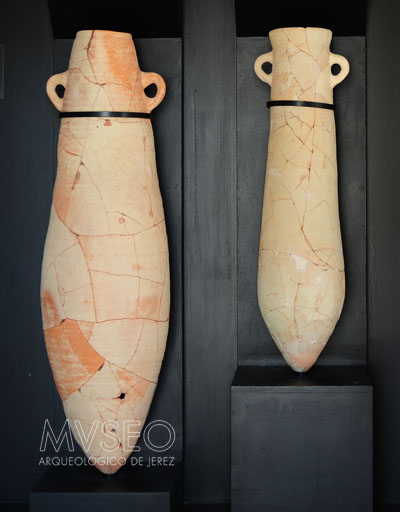PRE-ROMAN AMPHORAE
Protohistory
PRE-ROMAN AMPHORAE
Wheel-made pottery.
Height: 114 cm. Maximum diameter: 36 cm. Diameter at mouth: 13.3 cm.
Height: 91 cm. Maximum diameter: 25 cm. Diameter at mouth: 15 cm.
Protohistory. Around 3rd-2nd century B.C.
Origin
Los Garciagos. Jerez de la Frontera. Cádiz.
Description
Collection of western amphorae (late variety) from the site at Los Garciagos, located in the rich Jerez countryside, one of the few rural settlements known in the Pre-Roman period. Recent studies have dated it to between the second half of the 3rd century B.C. and the early 2nd century B.C. The largest piece belongs to the group known as “Tiñosa” and has a narrow mouth, thickened inside rim, no neck, slightly double truncated cone-shaped body and elliptical lug-shaped handles. The smaller amphora belongs to the “Carmona type”. It is characterised by a narrow mouth with slightly everted elongated lip, which begins just at the upper part of the handle and is separated from the body by several grooves. Cylindrical body gets narrower at the lower third and ends in a pointed base. Both varieties were discovered in the Lower Guadalquivir, and have recently been identified as local products from the Cádiz region. The first is more characteristic of the countryside and the second of the area around the Bay of Cádiz.
Bibliography
- González Rodríguez, R. (1987). “Cerro Naranja, Un asentamiento rural púnico en la campiña de Jerez”. Anuario Arqueológico de Andalucía. 1985/III. Sevilla, pp. 90-95.
- Carretero Poblete, P.A.; García Giménez, R. y Feliu Ortega, M.J. (2004): “Ánforas tipo Tiñosa. Análisis de la caracterización químico-mineralógica y su perspectiva histórica”. Avances de Arqueometría 2003. Universidad de Cádiz, pp. 183-198.

